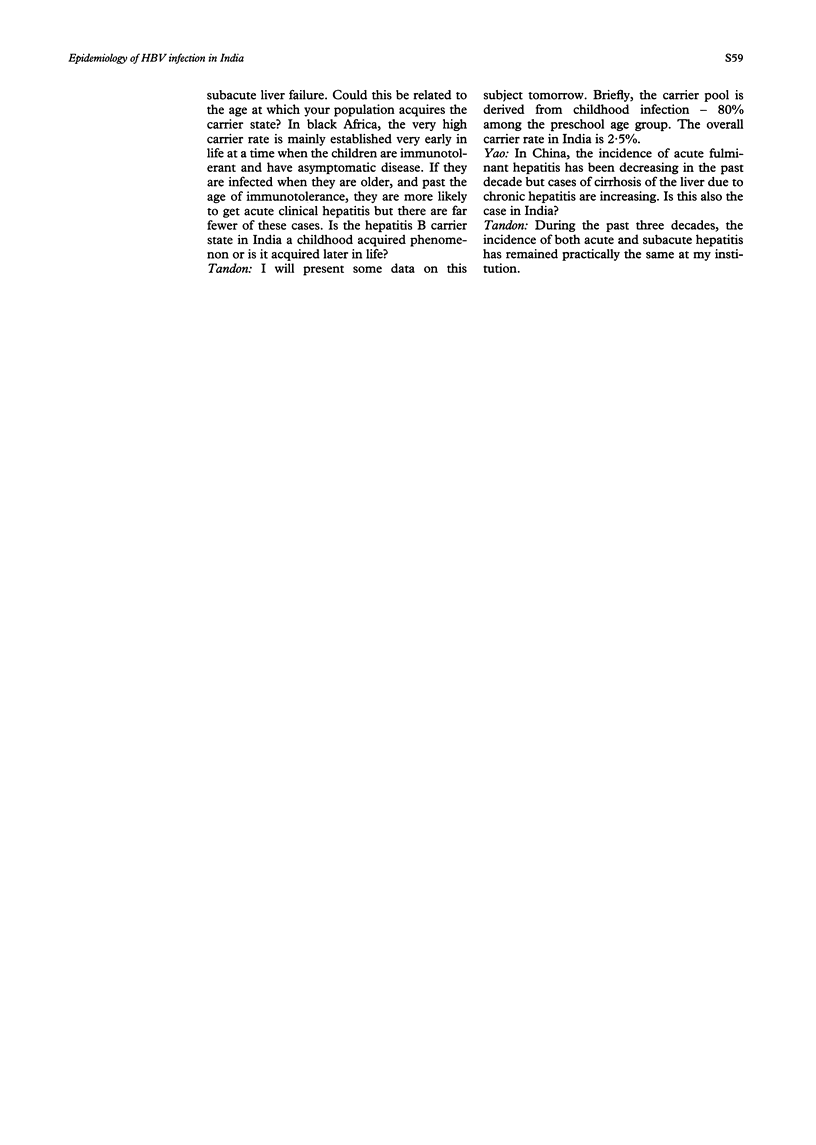Abstract
The average estimated carrier rate of hepatitis B virus (HBV) in India is 4%, with a total pool of approximately 36 million carriers. Wide variations in social, economic, and health factors in different regions may explain variations in carrier rates from one part of the country to another. Professional blood donors constitute the major high risk group for HBV infection in India, with a hepatitis B surface antigen positivity rate of 14%. Blood transfusions represent the most important route of HBV transmission among adults. However, most of India's carrier pool is established in early childhood, predominantly by horizontal spread due to crowded living conditions and poor hygiene. Acute and subacute liver failure are common complications of viral hepatitis in India and HBV is reckoned to be the aetiological agent in 42% and 45% of adult cases, respectively. HBV is reported to be responsible for 70% of cases of chronic hepatitis and 80% of cases of cirrhosis of the liver. About 60% of patients with hepatocellular carcinoma are HBV marker positive. Small numbers of patients have been reported to be infected with the pre-core mutant virus but none with the S mutant. Coinfection with hepatitis C virus or hepatitis delta virus is comparatively uncommon. In conclusion, hepatitis B is a major public health problem in India and will continue to be until appropriate nationwide vaccination programmes and other control measures are established.
Full text
PDF



Selected References
These references are in PubMed. This may not be the complete list of references from this article.
- Acharya S. K., Dasarathy S., Tandon B. N. Should we redefine acute liver failure? Lancet. 1993 Dec 4;342(8884):1421–1422. doi: 10.1016/0140-6736(93)92778-r. [DOI] [PubMed] [Google Scholar]
- Acharya S. K., Panda S. K., Duphare H., Dasarathy S., Ramesh R., Jameel S., Nijhawan S., Irshad M., Tandon B. N. Chronic hepatitis in a large Indian hospital. Natl Med J India. 1993 Sep-Oct;6(5):202–206. [PubMed] [Google Scholar]
- Aggarwal R., Naik S. R. Prevention of hepatitis B infection: the appropriate strategy for India. Natl Med J India. 1994 Sep-Oct;7(5):216–220. [PubMed] [Google Scholar]
- André F. E. Overview of a 5-year clinical experience with a yeast-derived hepatitis B vaccine. Vaccine. 1990 Mar;8 (Suppl):S74–S80. doi: 10.1016/0264-410x(90)90222-8. [DOI] [PubMed] [Google Scholar]
- Dasarathy S., Misra S. C., Acharya S. K., Irshad M., Joshi Y. K., Venugopal P., Tandon B. N. Prospective controlled study of post-transfusion hepatitis after cardiac surgery in a large referral hospital in India. Liver. 1992 Jun;12(3):116–120. doi: 10.1111/j.1600-0676.1992.tb00568.x. [DOI] [PubMed] [Google Scholar]
- Irshad M., Joshi Y. K., Acharya S. K., Tandon B. N. Prevalence of hepatitis B virus infection in healthy persons in North India. Natl Med J India. 1994 Sep-Oct;7(5):210–212. [PubMed] [Google Scholar]
- Irshad M., Singh Y. N., Acharya S. K. HBV--status in professional blood donors in north India. Trop Gastroenterol. 1992 Jul-Sep;13(3):112–114. [PubMed] [Google Scholar]
- Nayak N. C., Dhar A., Sachdeva R., Mittal A., Seth H. N., Sudarsanam D., Reddy B., Wagholikar U. L., Reddy C. R. Association of human hepatocellular carcinoma and cirrhosis with hepatitis B virus surface and core antigens in the liver. Int J Cancer. 1977 Nov 15;20(5):643–654. doi: 10.1002/ijc.2910200502. [DOI] [PubMed] [Google Scholar]
- Nayak N. C., Panda S. K., Zuckerman A. J., Bhan M. K., Guha D. K. Dynamics and impact of perinatal transmission of hepatitis B virus in North India. J Med Virol. 1987 Feb;21(2):137–145. doi: 10.1002/jmv.1890210205. [DOI] [PubMed] [Google Scholar]
- Panigrahi A. K., Nanda S. K., Dixit R. K., Acharya S. K., Zuckerman A. J., Panda S. K. Diagnosis of hepatitis C virus-associated chronic liver disease in India: comparison of HCV antibody assay with a polymerase chain reaction for the 5' noncoding region. J Med Virol. 1994 Oct;44(2):176–179. doi: 10.1002/jmv.1890440211. [DOI] [PubMed] [Google Scholar]
- Prasad S. R., Rodrigues F. M., Dhorje S. P., Ramamoorthy C. L. Prevalence & subtypes of hepatitis B surface antigen in the tribal population of Arunachal Pradesh, India. Indian J Med Res. 1983 Sep;78:300–306. [PubMed] [Google Scholar]
- Singhvi A., Pulimood R. B., John T. J., Babu P. G., Samuel B. U., Padankatti T., Carman R. H. The prevalence of markers for hepatitis B and human immunodeficiency viruses, malarial parasites and microfilaria in blood donors in a large hospital in south India. J Trop Med Hyg. 1990 Jun;93(3):178–182. [PubMed] [Google Scholar]
- Tandon B. N., Gandhi B. M., Joshi Y. K. Etiological spectrum of viral hepatitis and prevalence of markers of hepatitis A and B virus infection in north India. Bull World Health Organ. 1984;62(1):67–73. [PMC free article] [PubMed] [Google Scholar]
- Tandon B. N., Joshi Y. K., Krishnamurthy L., Tandon H. D. Subacute hepatic failure; is it a distinct entity? J Clin Gastroenterol. 1982 Aug;4(4):343-6, 362-4. doi: 10.1097/00004836-198208000-00010. [DOI] [PubMed] [Google Scholar]
- Trey C., Davidson C. S. The management of fulminant hepatic failure. Prog Liver Dis. 1970;3:282–298. [PubMed] [Google Scholar]


